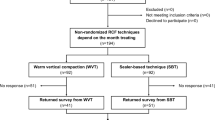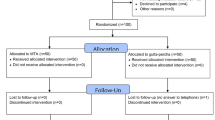Abstract
Objectives
The aim of this study was to compare the postoperative pain after root canal treatment using a carrier-based obturation system and two different sealers.
Materials and methods
In this prospective randomized clinical trial, 160 patients were selected. Patients with vital and devital teeth were randomized into four groups using a randomized block design with block sizes of 10 patients each. The groups were devital/vital teeth treated with iRoot SP sealer and devital/vital teeth treated with AH Plus sealer. Patients were prescribed ibuprofen, a 200-mg analgesic, if needed, and postoperative pain was recorded by visual analogue scale at 6, 12, 24, and 72 h after obturation. Pain score and frequency of tablet intake were recorded and statistically analyzed.
Results
Results showed that there was no significant difference between groups in the incidence of postoperative pain; however, iRoot SP sealer was associated with less analgesic intake compared to AH Plus sealer.
Conclusion
The use of different sealers did not significantly affect pain levels.
Clinical relevance
iRoot SP sealer was associated with less analgesic intake compared to AH Plus sealer.



Similar content being viewed by others
References
ElMubarak AHH, Abu-bakr NH, Ibrahim YE (2010) Postoperative pain in multiple-visit and single-visit root canal treatment. J Endod 36(1):36–39
Glassman G, Krasner P, Morse DR, Rankow H, Lang J, Furst ML (1989) A prospective randomized double-blind trial on efficacy of dexamethasone for endodontic interappointment pain in teeth with asymptomatic inflamed pulps. Oral Surg Oral Med Oral Pathol 67(1):96–100
Thakur S, Emil J, Paulaian B (2013) Evaluation of mineral trioxide aggregate as root canal sealer: a clinical study. J Conserv Dent 16:494–498
Alonso-Ezpeleta LO, Gasco-Garcia C, Castellanos-Cosano L, Martín-González J, López-Frías FJ, Segura-Egea JJ (2012) Postoperative pain after one-visit root-canal treatment on teeth with vital pulps: comparison of three different obturation technique. Med Oral Patol Oral Cir Bucal 17(4):721
Hale R, Gatti R, Glickman GN, Opperman LA (2012) Comparative analysis of carrier-based obturation and lateral compaction: a retrospective clinical outcomes study. Int J Dentistry 2012(3):954675
Goldberg F, Artaza LP, De Silvio A (2001) Effectiveness of different obturation techniques in the filling of simulated lateral canals. J Endod 27(5):362–364
Levitan ME, Himel VT, Luckey JB (2003) The effect of insertion rates on fill length and adaptation of a thermoplasticized gutta-percha technique. J Endod 29(8):505–508
Marin-Bauza GA, Rached-Junior FJA, Souza-Gabriel AE, Sousa-Neto MD, Miranda CES, Silva-Sousa YTC (2010) Physicochemical properties of methacrylate resin–based root canal sealers. J Endod 36(9):1531–1536
Zhang W, Li Z, Peng B (2009) Assessment of a new root canal sealer’s apical sealing ability. Oral Surg Oral Med Oral Pathol Oral Radiol Endod 107(6):79–82
Zhang BP (2015) Tissue reactions after subcutaneous and intraosseous implantation of iRoot SP, MTA and AH Plus. Dent Mater J 34:774–780
Alacam T (1985) Incidence of postoperative pain following the use of different sealers in immediate root canal filling. J Endod 11(3):135–137
Demirci GK, Calıskan MK (2016) A prospective randomized comparative study of cold lateral condensation versus core/gutta-percha in teeth with periapical lesions. J Endod 42(2):206–210
Graunaite I, Skucaite N, Lodine G, Agentiene I, Machiulskiene V (2018) Effect of resin-based and bioceramic root canal sealers on postoperative pain: a split-mouth randomized controlled trial. J Endod 44(5):689–693
Huskisson E (1974) Measurement of pain. Lancet 304(7889):1127–1131
Castelo-Baz P, Martin-Biedma B, Lopes MM, Pires-Lopes L, Silveira J, López-Rosales E, Varela-Patino P (2013) Ultramicroscopic study of the interface and sealing ability of four root canal obturation methods: Resilon versus gutta-percha. Australian Endod J 39(3):159–163
Omoigui S (2007) The biochemical origin of pain: the origin of all pain is inflammation and the inflammatory response. Part 2 of 3—inflammatory profile of pain syndromes. Med Hypotheses 69:1169–1178
Arias A, la Macorra J, Hidalgo J, Azabal M (2013) Predictive models of pain following root canal treatment: a prospective clinical study. Int Endod J 46(8):784–793
Ince B, Ercan E, Dalli M, Dulgergil CT, Zorba YO, Colak H (2009) Incidence of postoperative pain after single-and multi-visit endodontic treatment in teeth with vital and non-vital pulp. European J Dent 3(4):273
Genet J, Hart A, Wesselink P, Thoden van Velzen S (1987) Preoperative and operative factors associated with pain after the first endodontic visit. Int Endod J 20(2):53–64
Ali A, Olivieri JG, Duran-Sindreu F, Abella F, Roig M, Garcia-Font M (2016) Influence of preoperative pain intensity on postoperative pain after root canal treatment: a prospective clinical study. J Dent 45:39–42
Wang C, Xu P, Ren L, Dong G, Ye L (2010) Comparison of post-obturation pain experience following one-visit and two-visit root canal treatment on teeth with vital pulps: a randomized controlled trial. Int Endod J 43(8):692–697
De Andrade Risso P, da Cunha AJ, de Araujo MC, Luiz RR (2009) Postoperative pain and associated factors in adolescent patients undergoing two-visit root canal therapy. Aust Endod J 35(2):89–92
Segura-Egea JJ, Cisneros-Cabello R, Llamas-Carreras JM, Velasco-Ortega E (2009) Pain associated with root canal treatment. Int Endod J 42(7):614–620
Revill S, Robinson J, Rosen M, Hogg M (1976) The reliability of a linear analogue for evaluating pain. Anaesthesia 31(9):1191–1198
Clinton K, Himel VT (2001) Comparison of a warm gutta-percha obturation technique and lateral condensation. J Endod 27(11):692–695
Da Silva D, Endal U, Reynaud A, Portenier I, Orstavik D, Haapasalo M (2002) A comparative study of lateral condensation, heat-softened gutta-percha, and a modified master cone heat-softened backfilling technique. Int Endod J 35:1005–1011
Tennert C, Jungbäck IL, Wrbas K-T (2013) Comparison between two thermoplastic root canal obturation techniques regarding extrusion of root canal filling—a retrospective in vivo study. Clin Oral Investig 17(2):449–454
Qu W, Bai W, Liang Y-H, Gao X-J (2016) Influence of warm vertical compaction technique on physical properties of root canal sealers. J Endod 42(12):1829–1833
Heeren TJ, Levitan ME (2012) Effect of canal preparation on fill length in straight root canals obturated with RealSeal 1 and Thermafil plus. J Endod 38(10):1380–1382
Kucukyilmaz E, Savas S, Saygili G, Uysal B (2015) Assessment of apically extruded debris and irrigant produced by different nickel-titanium instrument systems. Braz Oral Research 29(1):1–6
Ricucci D, Rocas IN, Alves FR, Loghin S, Siqueira JF Jr (2016) Apically extruded sealers: fate and influence on treatment outcome. J Endod 42:243–249
Sadaf D, Ahmad M (2014) Factors associated with postoperative pain in endodontic therapy. Int J Biomed Sci 10:243–247
Wells LK, Drum M, Nusstein J, Reader A, Beck M (2011) Efficacy of ibuprofen and ibuprofen/acetaminophen on postoperative pain in symptomatic patients with a pulpal diagnosis of necrosis. J Endod 37:1608–1612
Al-Haddad A, Che Ab Aziz ZA (2016) Bioceramic-based root canal sealers: a review. Int J Biomater 9753210
Acknowledgements
This Project was registered at www.clinicaltrial.gov (ClinicalTrials.gov Identifier: NCT03029520).
Authorship Declaration
We hereby certify that this study has been composed by us and is based on our own work, unless stated otherwise. No other person’s work has been used without due acknowledgement in this study. All references and verbatim extracts have been quoted, and all sources of information, including graphs and data sets, have been specifically acknowledged.
Funding
The work was supported by Scientific Research Projects Coordination Center of Cukurova University (Project no. TDH-2015-4949), Adana, Turkey.
Author information
Authors and Affiliations
Corresponding author
Ethics declarations
Conflict of interest
The authors declare that they have no conflict of interest.
Ethical approval
All procedures performed in studies involving human participants were in accordance with the ethical standards of the institutional and/or national research committee and with the 1964 Helsinki declaration and its later amendments or comparable ethical standards.
Informed consent
Informed consent was obtained from all individual participants included in the study.
Rights and permissions
About this article
Cite this article
Atav Ates, A., Dumani, A., Yoldas, O. et al. Post-obturation pain following the use of carrier-based system with AH Plus or iRoot SP sealers: a randomized controlled clinical trial. Clin Oral Invest 23, 3053–3061 (2019). https://doi.org/10.1007/s00784-018-2721-6
Received:
Accepted:
Published:
Issue Date:
DOI: https://doi.org/10.1007/s00784-018-2721-6




